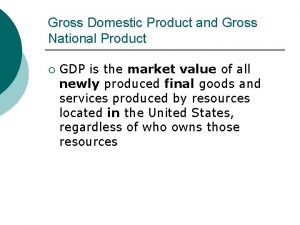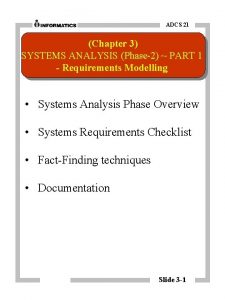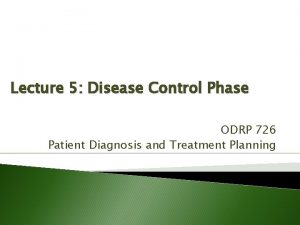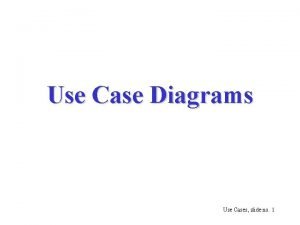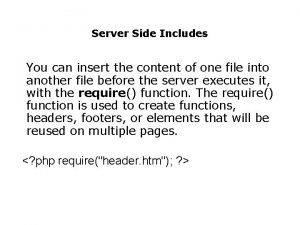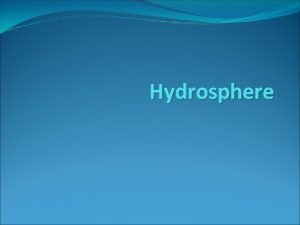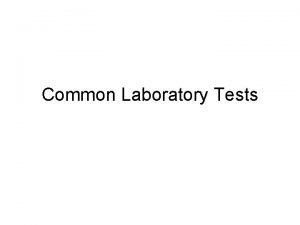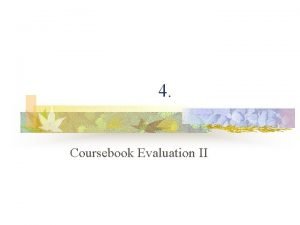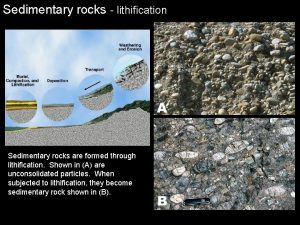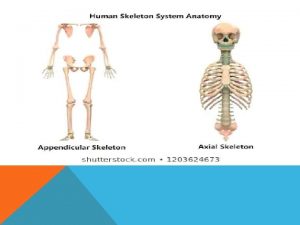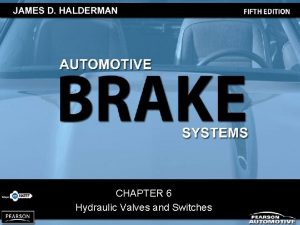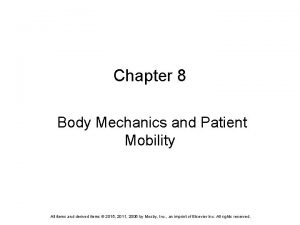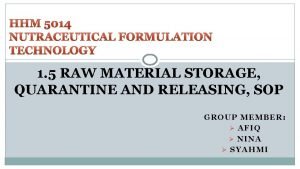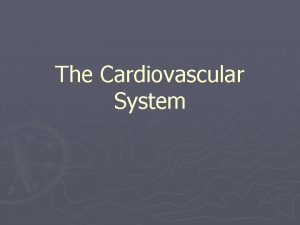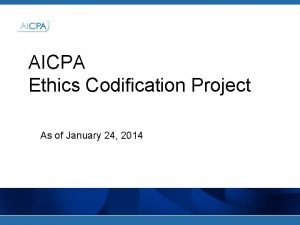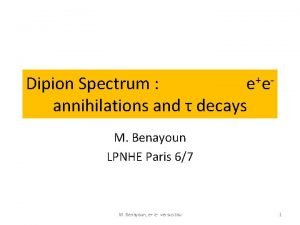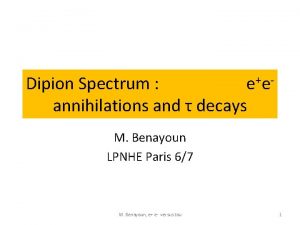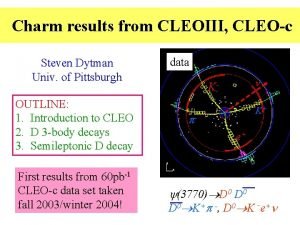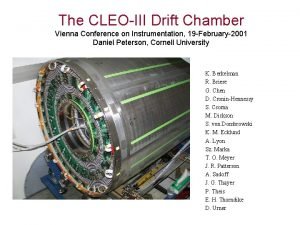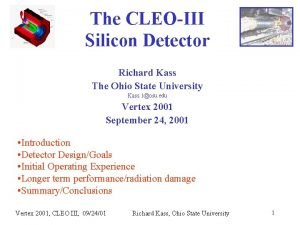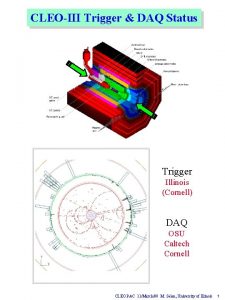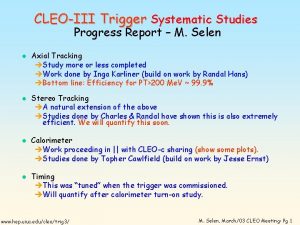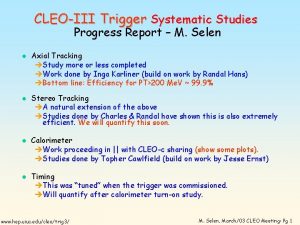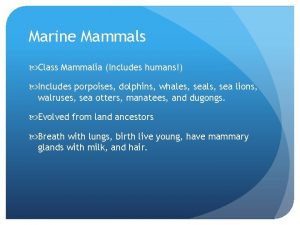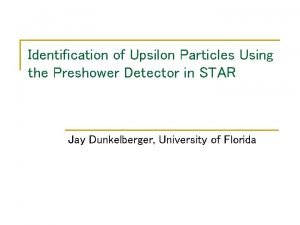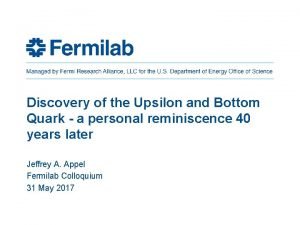CLEOIII Upsilon results In principle includes CLEOIII dipion

































- Slides: 33

CLEOIII Upsilon results • In principle, includes: • CLEO-III dipion transitions between vectors – Complements CLEO 05 results on transitions between L=1 P-states • High-precision measurement of dielectronic width of Y(1 S), (2 S) (3 S) • Many radiative results: – Observation of exclusives already presented: , KK, – Upper limits on and ’ modes – UL on multibody modes (>=4 charged tracks) – Comparison of inclusive quark/gluon production in radiative decays of Y vs. qq+photon (ISR)

CLEOIII CLEAN signals, angular analysis underway.

Dipion transitions • Renewed interest in `double-bump’ structure in (3 S) (1 S) following Ba. Bar observation of 4 S (n. S) Goal: spin/parity analysis across invariant mass to determine whether low-mass bump is sigma 0 – if not, what is it?

Exclusives: Multibody modes • Exclusive radiative events ‘bumps’ in the inclusive (scaled to Ebeam) photon spectrum (assume narrow recoil object) • We perform a series of fits to the inclusive photon spectra as a function of E in order to set an E -dependent upper limit on these radiative events. • Nota bene: ‘bumps’ in the inclusive photon spectra can also be caused by continuum threshold effects (ccbar, e. g. )

*→ + , → 4 MC An example, albeit exaggerated, of signal. . . (10 -2)

Method (Fitting Spectrum) • We fit each step to a Gaussian+Chebyshev polynomial • Step along the photon spectra with the Gaussian mean • Fix Gaussian sigma at each step to be the detector resolution (~1% @ 5 Ge. V) • Looking for narrow resonances so the measured photon energy dist. should be Gaussian with Gaussian width E.

Efficiencies ( *→ + , →? ) 4 4 K 4 p 2 p 2 K 2 2 K 4 0 4 K 0 4 p 0 2 p 2 0 59 2% 50 2% 67 2% 62 3% 56 2% 53 3% 60 2% 48 2% 65 2% 54 5% 2 p 2 K 0 2 2 K 0 4 2 0 4 K 2 0 4 p 2 0 2 p 2 K 2 0 2 2 K 2 0 4 4 0 4 6 0 50 5% 53 2% 59 1% 49 2% 63 5% 57 2% 54 3% 57 2% 60 2% 4 8 0 6 6 K 6 p 60 2% 74 3% 68 4% 52 4% Worst Phase Space High Mult.

All limits on the order of 10 -4

In/Out and Sensitivity Check • Embed signals at a given level into data. • We then apply our procedure to the resulting spectra • We construct all signals above our upper limit floor (~10 -4) in our accessible recoil mass range

A(M )+1. 645* A(M )

d. N/d(A/ A)(< (1 S)) Check of pulls: Continuum data A/ A

Results • Our sensitivity is of order 10 -4 across all accessible values of M • Above threshold for any known B( (1 S)→ +pseudoscalar, pseudoscalar h+h-+neutrals) • We measure for all M : B( (1 S)→ + , 4 charged tracks) < B( (2 S)→ + , 4 charged tracks) < B( (3 S)→ + , 4 charged tracks) < 1. 05 x 10 -3 1. 65 x 10 -3 5. 70 x 10 -3

Results (2) • Restricting M to 1. 5 Ge. V < M < 5. 0 Ge. V we measure: 1. 82 x 10 -4 1. 69 x 10 -4 3. 00 x 10 -4 • We report these upper limits as a function of recoiling mass M (see conf. Paper) • B. R. ’s are all ~10 -4. • N. B. Not in conflict with any observed two -body radiative decays to-date (due to 4 charged track requirement here) B( (1 S)→ + , 4 charged tracks) < B( (2 S)→ + , 4 charged tracks) < B( (3 S)→ + , 4 charged tracks) <

Many modes! Dedicated search for 1 S gh and 1 S gh’; Observed in J/psi decay at 10 -4 and 4. 7 x 10 -4 level

Only upper limits quoted at this time… Suggests dedicated search for (1 S) c?

Quarks v. Gluons • 1981 (CESR): e+e- collisions (ECM ~ 10 Ge. V) produce ; ggg allows high-statistics study of gluon fragmentation • Isolate gluons: ggg decay of Isolate quarks: fragmentation • 1984 Find: more baryons/event in ggg decay than • Weakness: 3 partons (ggg) vs. 2 partons ( ) 3 strings (ggg) vs. 1 string ( ) • Solution: decay of vs. decay of continuum

Y(1 S) 3 gluons, but also 2 -gluon source: • e+e- (CLEO) • e+e- (1 S) (CLEO) • e+e- Z 0 (LEP) Z 0

Data Sets Data Set 1 S 2 S 3 S 4 S Below 4 S Luminosity (1/fb) 1. 19 1. 07 1. 42 5. 52 2. 10 ECM (Ge. V) 9. 46 10. 02 10. 36 10. 58 10. 55 Note that for 2 S and 3 S have not corrected for cascades: • (2 S) (1 S) + X • (3 S) (2 S) + X (3 S) (1 S) + X Are included as consistency checks, but have subtractions and corrections that have not been included.

Method: vs. • Bin according to particle momentum • Count N(Baryon) per bin and normalize to hadronic event count • Enhancement is: Continuum-subtracted Resonance Yield Continuum Yield Enhancement = 1. 0 Particle is produced as often on resonance as on continuum

Method: vs. • Bin particle yield recoiling against high-E photon according to tagged photon momentum • Count N(Baryon) per bin and normalize to photon count in that bin • Enhancement is: Continuum-subtracted Resonance Yield Continuum Yield Enhancement = 1. 0 Particle is produced as often on resonance as on continuum

Detector and Generator Level: ggg manageable bias; use correction factor where appropriate; discrepancy in/out used for systematics Λ p p φ

Proton L f f 2 results • Successfully reproduce CLEO 84 indications of baryon enhancement in 1 S (ggg) vs. CO ( ) fragmentation • Comparison of baryon production in 1 S ggγ vs. e+e- (comparing two gluon to two quark fragmentation) -1 S gg baryons shows much reduced enhancement relative to baryons -Effect not reproduced in JETSET MC Ggg/qqbar Ggγ/qqbargamma Ratio p 1. 30 ± 0. 01 1. 10 ± 0. 02 ~ 1. 2 Antip 1. 33 ± 0. 01 1. 19 ± 0. 03 ~1. 1 Λ 2. 56 ± 0. 02 1. 97 ± 0. 03 ~1. 3 φ 0. 85 ± 0. 03 1. 1 ± 0. 3 ~0. 8 f 2 0. 66 ± 0. 04 1. 4 ± 0. 9 ~0. 5

Deuteron Production (Preliminary) B(1 S (ggg+gg )) d+X= 2. 86(0. 30)x 10 -5 Per event enhancement of deuteron production in gluons vs. quarks ~12. 0(2. 0). Also: note 1 S psi >> continuum psi

Summary • Radiative decays (in general) continue to be more elusive than for J/psi • Baryon coupling to 3 -gluons confirmed (even larger for deuterons!); enhancement in 2 -gluons mitigated. • Ramping down these efforts (CLEO-III CLEOc) • Future improvements/results hopefully to emerge from B-factories with dedicated Upsilon running • Thanks to everyone who did the work!

Overview • Reproducing CLEO 84 indications of baryon enhancement in 1 S (ggg) vs. CO ( ) fragmentation • New comparison of baryon production in 1 S ggγ vs. e+e- comparing two gluon to two quark fragmentation -First time such a comparison has been made • Essential results: -1 S gg baryons shows much reduced enhancement relative to baryons -Effect not reproduced in JETSET MC • Additional cross-checks (2 S, 3 S, comparison with mesons) included

Data Results: ggg p and p: 2 S/3 S data corrected

Data Results: ggγ Λ: 2 S corrected

Method (Extracting Limit) • Plot the gaussian area A(x ) from fits to inclusive photon spectra • Convert into an upper limit contour with height=A(x )+ 1. 645* A(x ) • A(x ) is the Gaussian fit sigma • Negative points → 1. 645* A(x )

The M -Dependent Upper Limits • Divide on-resonance fits by efficiency corrected number of (1 S), (2 S) and (3 S) events (-1 events) • Divide off-resonance fits by luminosity of off-resonance running and derive xsct UL’s • Note: +f 2(1270) will not show up in this analysis since B (f 2 4 tracks) is approximately 3% • B ( (1 S) + , + - 0) << 10 -4

CHECK OF PULL DISTRIBUTIONS

Fragmentation Models • Simplistically there are two models: Parton vs. String • Parton: g or q radiates a new particle • String: g and q are connected by a string (gluon). Particles move apart; string stretches and breaks; forms new particles e+ q e- • String model is what is in Jet. Set MC (CLEO: Jetset 7. 4 PYTHIA) Parameters tuned to √s = 90 Ge. V LEP Data

Data Results • Show data and detector level MC enhancements for both ggg and ggγ • “Corrected” data and generator level MC enhancements for those with a low CL fit. • Systematic errors have been introduced based on the correction factor.

Data Results: Momentum-Integrated 1 1 Λ p p φ f 2 Λ p φ f 2
 Procedural self
Procedural self Sport includes all forms of
Sport includes all forms of Demand-pull inflation occurs when
Demand-pull inflation occurs when Analyze phase - includes
Analyze phase - includes Biomolecule
Biomolecule Disease control phase dental
Disease control phase dental What are the part of ecosystem
What are the part of ecosystem Case diagram
Case diagram Back end phases of compiler
Back end phases of compiler What is setting
What is setting Management accounting scope
Management accounting scope Php server side includes
Php server side includes Short note on hydrosphere
Short note on hydrosphere Calculating mcv
Calculating mcv Functions of commercial banks
Functions of commercial banks The term receivables includes all
The term receivables includes all Which is the sixth step in iot design methodology?
Which is the sixth step in iot design methodology? Course book package includes
Course book package includes Business intelligence includes
Business intelligence includes In sedimentary rocks lithification includes
In sedimentary rocks lithification includes Tissues in circulatory system
Tissues in circulatory system Labeling appendicular skeleton
Labeling appendicular skeleton A brake system metering valve
A brake system metering valve Chapter 8 body mechanics and patient mobility
Chapter 8 body mechanics and patient mobility Purpose of narrative essay
Purpose of narrative essay Which sentence contains a gerund?
Which sentence contains a gerund? Includes anything visible and tangible in form
Includes anything visible and tangible in form An ecosystem includes
An ecosystem includes One effect of high-speed driving is speed smear in which
One effect of high-speed driving is speed smear in which Photosynthesis includes both answers
Photosynthesis includes both answers Quarantine includes storage of
Quarantine includes storage of The cardiovascular system includes the
The cardiovascular system includes the Formal tone
Formal tone The aicpa ethics codification includes which sections
The aicpa ethics codification includes which sections


